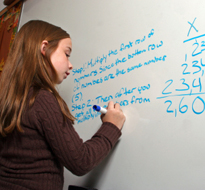
Over the past 50 years, American children have been growing up in increasingly diversified family structures. As divorce, remarriage, cohabitation and other such events have refashioned home life, studies have found that transitions for children can have negative educational consequences.
A 2011 study published in the Journal of Marriage and Family, “Effects of Family Structure Type and Stability on Children’s Academic Performance Trajectories,” examined data from more than 8,000 children to compare academic growth from kindergarten to fifth grade among three types of traditional families and three alternative forms. The study evaluates a combination of factors — structure, transitions, family financial and social resources, and child outcomes — at various points in time.
The study’s findings include:
- Consistent with some previous research, children in non-disrupted single-parent and disrupted two-biological-parent families saw slower academic growth relative to both non-disrupted two-biological-parent and non-disrupted stepfamilies.
- Non-disrupted single-parent families that had structural stability saw academic benefits for children over time compared to unstable alternative families with multiple disruptions.
- Income and parental education at the time children began kindergarten had significant and positive relationships with a child’s growth in math.
- Slower academic progress in alternative and disrupted families was either “completely or partially attributable to a shortage of financial, human, and parenting resources in these families” at the time of kindergarten.
- Controlling for resource levels at the time of kindergarten, the differences between traditional and most types of alternative families were reduced to a “nonsignificant level.” Only disrupted families with multiple transitions continued to show a less positive performance trajectory.
The authors state that, in contrast to previous studies that focused merely on the negative impact of alternative family structures and disruptions, these findings elucidate the “roles of family resources and resource changes in explaining performance trajectory differences.”
Tags: children, family, marriage, poverty, inequality, parenting, academic performance, child development, family instability, family structure, growth-curve models, hierarchical linear models.
